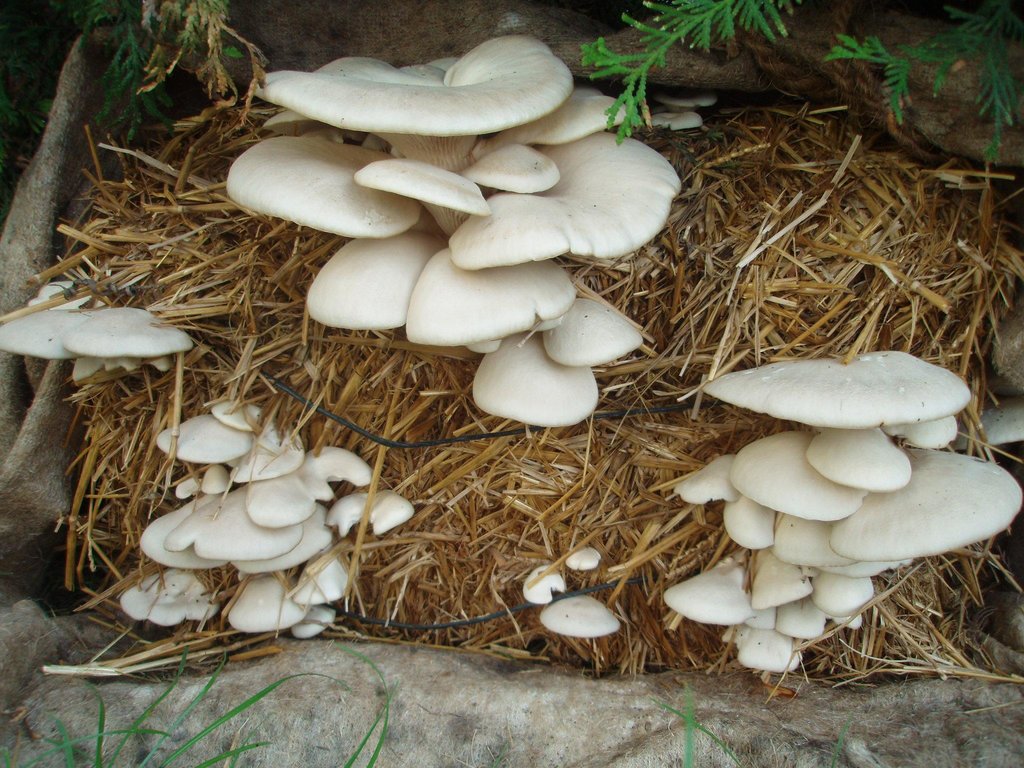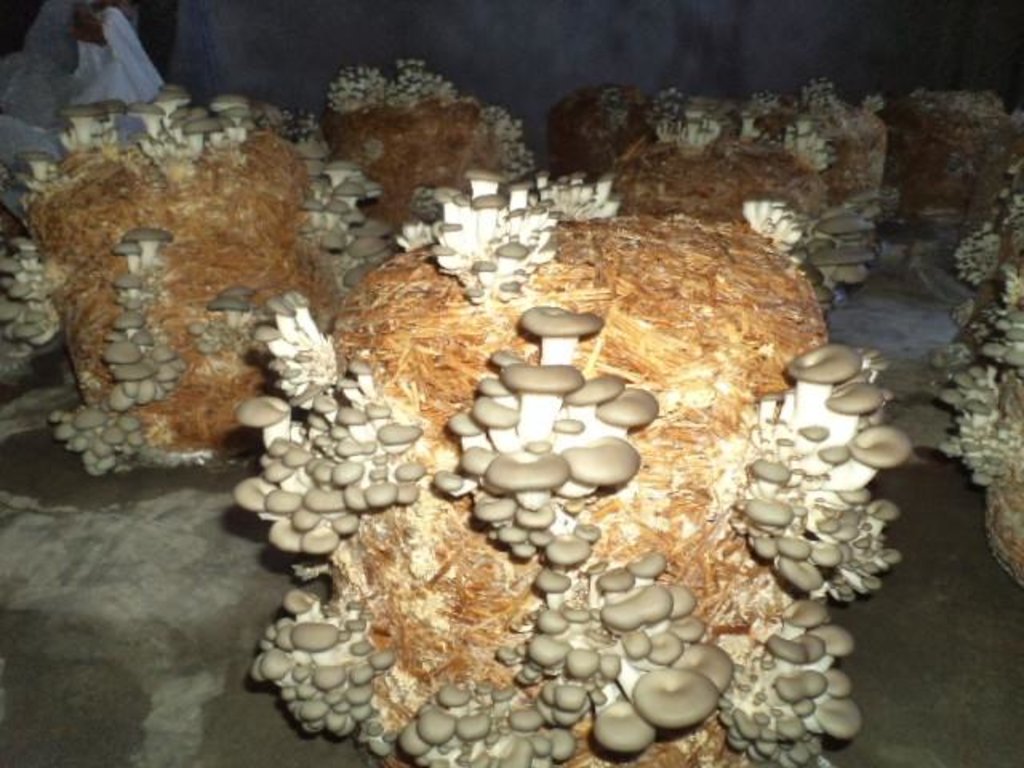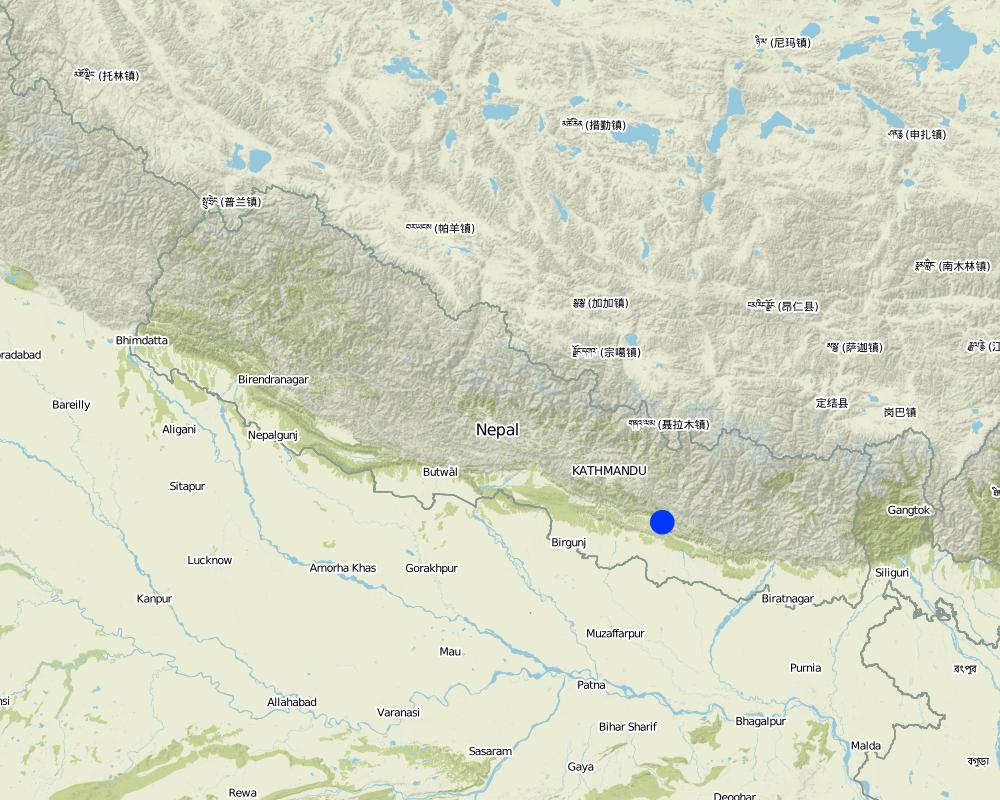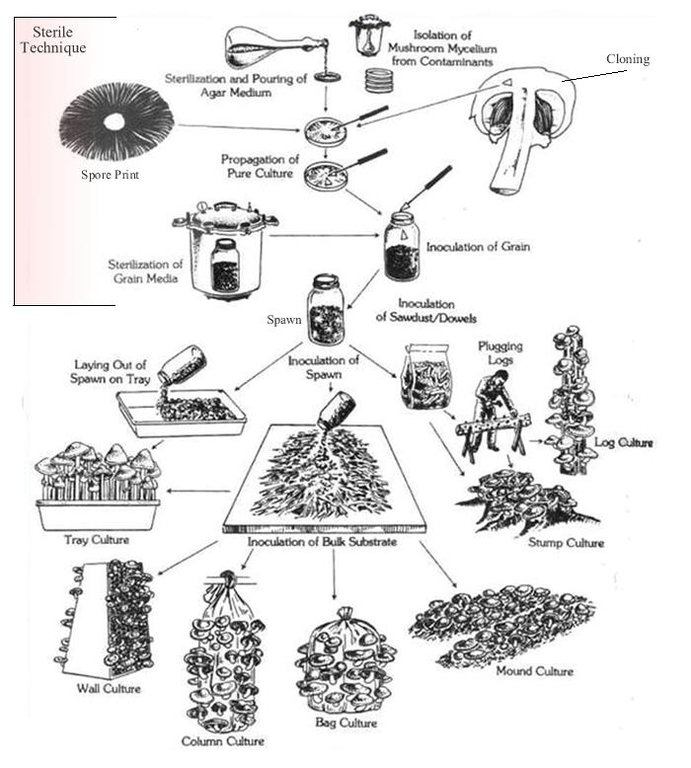Oyster Mushroom [Nepal]
- Creation:
- Update:
- Compiler: Sabita Aryal
- Editor: –
- Reviewer: David Streiff
Parale Chyau
technologies_1194 - Nepal
View sections
Expand all Collapse all1. General information
1.2 Contact details of resource persons and institutions involved in the assessment and documentation of the Technology
SLM specialist:
Dahal Dikshya
Nepal
SLM specialist:
Karki Nabina
Nepal
SLM specialist:
Budhathoki Karuna
Nepal
SLM specialist:
Ghimire Kishor
9844148065
Agricultural Office, Sindhuli
Nepal
SLM specialist:
Singh Yubraj
9841673072
Agricultural Office, Sindhuli
Nepal
SLM specialist:
Neupane Shankar
01-5010090
Management Post Institution Lalitpur, Hattiban
Nepal
Name of the institution(s) which facilitated the documentation/ evaluation of the Technology (if relevant)
Kathmandu University (KU) - NepalName of the institution(s) which facilitated the documentation/ evaluation of the Technology (if relevant)
District Agriculture Development Office, Sindhuli (DADO) - Nepal1.3 Conditions regarding the use of data documented through WOCAT
The compiler and key resource person(s) accept the conditions regarding the use of data documented through WOCAT:
Ja
2. Description of the SLM Technology
2.1 Short description of the Technology
Definition of the Technology:
Oyster Mushroom Farming Technology is the cultivation of oyster mushrooms as a food source, economic source, and as primary compost, to increase the quality of soil and help upgrade living standards of local farmers.
2.2 Detailed description of the Technology
Description:
The technology is carried out in Kamalamai Municipality, Sindhuli District, Janakpur, Nepal. The Pennsylvania Department Of Environmental Protection (DEP), other regulator agencies and the community are at charge. Oyster were identified as being both economically viable and suited for local cultivation. Nepal Agriculture Research Council (NARC) and a few private organizations are the major resources centers for supplying the quality spawn to the farmer/growers.
Purpose of the Technology: The main purpose of this document is to provide uniform instructions and operating procedures for the use or disposal of mushroom compost (as soil amendment or conditioner). Another basic purpose is use of mushroom as food and income source for local farmers.
Establishment / maintenance activities and inputs: Best Practices for Environmental Protection in the Mushroom Farm
Community (1997) was developed as a result of realization among authorities of Pennsylvania DEP, to help people to understand that farms are operating according to the highest environmental standards, and will help improve coexistence with nearby residents, through environmental regulation. This implemented a mushroom farm development for specific operations with the natural resource conservation. The member co-ordination, knowledge, and experiences are critical in establishing the practices as workable and rational means to meet the goal of environmental protection and agricultural operation.
Natural / human environment: Mushroom Farm Environmental Management Plan (MFEMP) is designed to prevent pollution or danger of ground or surface water on common health, by helping in maintaining/improving the condition of soil, and prevent the pollution of surface water, groundwater and air, as well, at little or no cost. This technology helps local farmers to increase soil fertility and act as a good income source in small scale.
2.3 Photos of the Technology
2.5 Country/ region/ locations where the Technology has been applied and which are covered by this assessment
Country:
Nepal
Region/ State/ Province:
Janakpur
Further specification of location:
Sindhuli
Map
×2.7 Introduction of the Technology
Comments (type of project, etc.):
This practice was performed by American mushroom institutions in 1997 and earlier 1984.
3. Classification of the SLM Technology
3.1 Main purpose(s) of the Technology
- improve production
- create beneficial economic impact
3.2 Current land use type(s) where the Technology is applied

Other
Comments:
Major land use problems (compiler’s opinion): Low productivity of land, soil erosion, water scarcity, cultivation of land slopes, tillage resulting in soil loss.
Major land use problems (land users’ perception): Infertility of land, having to use fertilizers and pesticides, scarcity of water for irrigation, having to plow farm seasonally and repeatedly.
Constraints of recreation: Dark and moist environment is necessary.
3.3 Further information about land use
Specify:
Longest growing period in days: 75; Longest growing period from month to month: January-March
3.4 SLM group to which the Technology belongs
- integrated soil fertility management
3.5 Spread of the Technology
Comments:
Total area covered by the SLM Technology is 12*18 inch.
The straw and spawn (mushroom) should be packed in plastic bags. Two or three inches of straw are packed into the plastic bag and the spawn is lightly sprinkled on top. This should be repeated until the bag is almost filled, the top of the plastic should be closed and holes should be poked in the bag.
3.6 SLM measures comprising the Technology

agronomic measures
- A2: Organic matter/ soil fertility
Comments:
Type of agronomic measures: cover cropping, mulching, manure / compost / residues, zero tillage / no-till
3.7 Main types of land degradation addressed by the Technology

chemical soil deterioration
- Cn: fertility decline and reduced organic matter content (not caused by erosion)
Comments:
Main causes of degradation: soil management (soil erosion, low productivity of land, tillage), overgrazing (Fodder for domestic animals such as cow, buffalo, goat etc.), change in temperature (Uneven rainfall, long dry or cold seasons)
Secondary causes of degradation: crop management (annual, perennial, tree/shrub) (terrace farming problems), deforestation / removal of natural vegetation (incl. forest fires) (Use of timber for burning), over-exploitation of vegetation for domestic use (Only required vegetation was used), poverty / wealth (Medium to large scale production costly for local farmers)
3.8 Prevention, reduction, or restoration of land degradation
Specify the goal of the Technology with regard to land degradation:
- prevent land degradation
- reduce land degradation
Comments:
Secondary goals: prevention of land degradation
4. Technical specifications, implementation activities, inputs, and costs
4.1 Technical drawing of the Technology
4.2 Technical specifications/ explanations of technical drawing
It is kept in a room with temperature 22-28 degree.
Location: Room. Sindhuli
Technical knowledge required for field staff / advisors: moderate (Knowledge on preparing substrate, incubation period and harvesting of mushroom and proper use of mushroom compost.)
Technical knowledge required for land users: low (Since land usage is very less.)
Main technical functions: control of dispersed runoff: retain / trap, increase of surface roughness, improvement of topsoil structure (compaction), improvement of subsoil structure (hardpan), increase in organic matter, increase of infiltration, water spreading, improvement of water quality, buffering / filtering water, increase of biomass (quantity)
Secondary technical functions: stabilisation of soil (eg by tree roots against land slides), increase in nutrient availability (supply, recycling,…), increase / maintain water stored in soil, sediment retention / trapping, sediment harvesting
Mulching
Material/ species: straw and spawn
Quantity/ density: 2:1
Construction material (earth): mud in cement
Construction material (stone): stone
Construction material (wood): wood plants
4.3 General information regarding the calculation of inputs and costs
other/ national currency (specify):
Rupees
Indicate exchange rate from USD to local currency (if relevant): 1 USD =:
90.0
Indicate average wage cost of hired labour per day:
5.00
4.5 Costs and inputs needed for establishment
| Specify input | Unit | Quantity | Costs per Unit | Total costs per input | % of costs borne by land users | |
|---|---|---|---|---|---|---|
| Construction material | Straw | unit | 1.0 | 15.0 | 15.0 | 100.0 |
| Construction material | Container | unit | 1.0 | 990.0 | 990.0 | |
| Construction material | Fuel | unit | 1.0 | 125.0 | 125.0 | |
| Construction material | Stove | unit | 1.0 | 770.0 | 770.0 | |
| Construction material | Plastic | unit | 1.0 | 10.0 | 10.0 | |
| Construction material | Cutting Machine | unit | 1.0 | 300.0 | 300.0 | |
| Total costs for establishment of the Technology | 2210.0 | |||||
4.6 Maintenance/ recurrent activities
| Activity | Type of measure | Timing/ frequency | |
|---|---|---|---|
| 1. | Method of cutting straw | Agronomic | dry season |
| 2. | Warming the straw | Agronomic | dry season |
| 3. | Harvesting the mushroom | Agronomic | dry season |
| 4. | Maintainance of mushroom | Agronomic | dry season |
4.7 Costs and inputs needed for maintenance/ recurrent activities (per year)
| Specify input | Unit | Quantity | Costs per Unit | Total costs per input | % of costs borne by land users | |
|---|---|---|---|---|---|---|
| Labour | Method of cutting straw | persons/day | 1.0 | 150.0 | 150.0 | 100.0 |
| Total costs for maintenance of the Technology | 150.0 | |||||
Comments:
Machinery/ tools: plastic bag,water storage tank.
4.8 Most important factors affecting the costs
Describe the most determinate factors affecting the costs:
Labour should be managed properly.
5. Natural and human environment
5.1 Climate
Annual rainfall
- < 250 mm
- 251-500 mm
- 501-750 mm
- 751-1,000 mm
- 1,001-1,500 mm
- 1,501-2,000 mm
- 2,001-3,000 mm
- 3,001-4,000 mm
- > 4,000 mm
Indicate the name of the reference meteorological station considered:
DADO Sindhuli, 2010
Agro-climatic zone
- arid
Thermal climate class: subtropics. Mostly mushroom grow in about 24 degree Celsius.
Mostly mushroom grow in about 24 degree Celsius.
5.2 Topography
Slopes on average:
- flat (0-2%)
- gentle (3-5%)
- moderate (6-10%)
- rolling (11-15%)
- hilly (16-30%)
- steep (31-60%)
- very steep (>60%)
Landforms:
- plateau/plains
- ridges
- mountain slopes
- hill slopes
- footslopes
- valley floors
Altitudinal zone:
- 0-100 m a.s.l.
- 101-500 m a.s.l.
- 501-1,000 m a.s.l.
- 1,001-1,500 m a.s.l.
- 1,501-2,000 m a.s.l.
- 2,001-2,500 m a.s.l.
- 2,501-3,000 m a.s.l.
- 3,001-4,000 m a.s.l.
- > 4,000 m a.s.l.
Comments and further specifications on topography:
Landforms: Flat surface is needed.
5.3 Soils
If available, attach full soil description or specify the available information, e.g. soil type, soil PH/ acidity, Cation Exchange Capacity, nitrogen, salinity etc.
Soil water storage capacity is medium: Mushroom need water daily two times.
5.4 Water availability and quality
Availability of surface water:
medium
Water quality (untreated):
for agricultural use only (irrigation)
Comments and further specifications on water quality and quantity:
Availability of surface water: May face scarcity of drinking water in dry seasons.
5.5 Biodiversity
Species diversity:
- medium
Comments and further specifications on biodiversity:
Found mostly in eastern region, and almost in the western parts as well.
5.6 Characteristics of land users applying the Technology
Off-farm income:
- 10-50% of all income
Relative level of wealth:
- average
- rich
Individuals or groups:
- individual/ household
Gender:
- women
- men
Indicate other relevant characteristics of the land users:
Land users applying the Technology are mainly common / average land users
Difference in the involvement of women and men: There is no difference in involvement of men and women in this technology, both can be involved.
Population density: > 500 persons/km2
Annual population growth: 3% - 4%
15% of the land users are rich and own 20% of the land.
5.7 Average area of land owned or leased by land users applying the Technology
- < 0.5 ha
- 0.5-1 ha
- 1-2 ha
- 2-5 ha
- 5-15 ha
- 15-50 ha
- 50-100 ha
- 100-500 ha
- 500-1,000 ha
- 1,000-10,000 ha
- > 10,000 ha
Is this considered small-, medium- or large-scale (referring to local context)?
- medium-scale
5.8 Land ownership, land use rights, and water use rights
Land ownership:
- communal/ village
Land use rights:
- open access (unorganized)
- individual
Comments:
It is found that this technique is used even by people with little amount of land.
5.9 Access to services and infrastructure
health:
- poor
- moderate
- good
education:
- poor
- moderate
- good
technical assistance:
- poor
- moderate
- good
employment (e.g. off-farm):
- poor
- moderate
- good
markets:
- poor
- moderate
- good
energy:
- poor
- moderate
- good
roads and transport:
- poor
- moderate
- good
drinking water and sanitation:
- poor
- moderate
- good
financial services:
- poor
- moderate
- good
6. Impacts and concluding statements
6.1 On-site impacts the Technology has shown
Socio-economic impacts
Production
crop production
Comments/ specify:
Mushroom Compost usage
fodder production
Comments/ specify:
Leftover straw
fodder quality
Comments/ specify:
Richer in nutrients than dry hay
Water availability and quality
demand for irrigation water
Income and costs
expenses on agricultural inputs
Comments/ specify:
Little to no cost required
farm income
Comments/ specify:
Mushrooms sold widely as food source
diversity of income sources
Comments/ specify:
Recreational method, provides options for farmers
economic disparities
workload
Comments/ specify:
1 or 2 individuals are enough.
Socio-cultural impacts
food security/ self-sufficiency
Comments/ specify:
Cheap and easy way for earning money
health situation
Comments/ specify:
Mushroom compost used instead of chemical fertilizers
recreational opportunities
Comments/ specify:
Good way to utilize time, gain profits
SLM/ land degradation knowledge
situation of socially and economically disadvantaged groups
livelihood and human well-being
Comments/ specify:
It has helped to increase knowledge
Ecological impacts
Soil
soil cover
Comments/ specify:
Provide nutrients to plants
nutrient cycling/ recharge
Comments/ specify:
Composting
Biodiversity: vegetation, animals
biomass/ above ground C
Comments/ specify:
Composting
plant diversity
Comments/ specify:
Mushroom: edible fungi
pest/ disease control
Comments/ specify:
Alternative mushroom composts
6.2 Off-site impacts the Technology has shown
damage on neighbours' fields
6.3 Exposure and sensitivity of the Technology to gradual climate change and climate-related extremes/ disasters (as perceived by land users)
Gradual climate change
Gradual climate change
| Season | Type of climatic change/ extreme | How does the Technology cope with it? | |
|---|---|---|---|
| annual temperature | increase | well |
Climate-related extremes (disasters)
Meteorological disasters
| How does the Technology cope with it? | |
|---|---|
| local rainstorm | not known |
| local windstorm | not known |
Climatological disasters
| How does the Technology cope with it? | |
|---|---|
| drought | not well |
Hydrological disasters
| How does the Technology cope with it? | |
|---|---|
| general (river) flood | not known |
Other climate-related consequences
Other climate-related consequences
| How does the Technology cope with it? | |
|---|---|
| reduced growing period | not known |
Comments:
The technology could be made more tolerant by keeping the room dark and warm (22-28 degrees), and carry out cultivation in almost all seasons (except winter).
6.4 Cost-benefit analysis
How do the benefits compare with the establishment costs (from land users’ perspective)?
Short-term returns:
positive
Long-term returns:
slightly positive
How do the benefits compare with the maintenance/ recurrent costs (from land users' perspective)?
Short-term returns:
positive
Long-term returns:
positive
Comments:
Yes,this technology can give both short-term returns and long-term returns.Positive result because it is the best type of production for the environment and economic resources.
6.5 Adoption of the Technology
- single cases/ experimental
If available, quantify (no. of households and/ or area covered):
3 households covering 32 percent of stated area
Of all those who have adopted the Technology, how many have did so spontaneously, i.e. without receiving any material incentives/ payments?
- 10-50%
Comments:
2 land user families have adopted the Technology with external material support
Comments on acceptance with external material support: By government point of view almost all members of a village and city, both can cultivate this technology.
1 land user families have adopted the Technology without any external material support
Comments on spontaneous adoption: Without external support also this technology can be carried out.
There is a moderate trend towards spontaneous adoption of the Technology
Comments on adoption trend: Best Practices for Environmental Protection in the Mushroom Farm
Community
6.7 Strengths/ advantages/ opportunities of the Technology
| Strengths/ advantages/ opportunities in the land user’s view |
|---|
|
It is used as vegetable. How can they be sustained / enhanced? It gives nutrients. |
|
Waste water management How can they be sustained / enhanced? Waste water can be used as part of this farming. |
|
It is used as manure How can they be sustained / enhanced? High productivity |
|
Good income source How can they be sustained / enhanced? Requires less space and materials. Easily cultivated in favorable season. Can be sold commercially because of its food value. |
| Strengths/ advantages/ opportunities in the compiler’s or other key resource person’s view |
|---|
|
Erosion and sedimentation control How can they be sustained / enhanced? This section looks at the soil, geology, ground cover and other natural feature site, by providing nutrients to the soil as a conditioner. |
|
Surface water and stormwater management How can they be sustained / enhanced? At most mushroom farm operation stormwater run off can be divide into uncontaminated and contaminated water. |
|
Economic purpose How can they be sustained / enhanced? Constructed to increase income source with little initiation cost. Substrate can be used as compost, so no need for chemical fertilizers. |
|
Nutrient management for substrate utilization How can they be sustained / enhanced? The season methods and amount of nutrient used to maintain the technology. |
|
Integrated pest management How can they be sustained / enhanced? Pest control may be accompained by using non-chemical or alternative controls. |
6.8 Weaknesses/ disadvantages/ risks of the Technology and ways of overcoming them
| Weaknesses/ disadvantages/ risks in the land user’s view | How can they be overcome? |
|---|---|
| Place for growing | All locals do not have spare rooms or sheds for mushroom cultivation. This proves to be a huge disadvantage as they require dark room and moist conditions. |
| Weaknesses/ disadvantages/ risks in the compiler’s or other key resource person’s view | How can they be overcome? |
|---|---|
| Less theoritical knowledge | Locals should be made aware about growing technologies that can help increase their quality of life. |
| Place for growing | Rooms or shed may not always be available. Providing darkness during can be a problem. |
| Seasonal problem | Room temperature required is 20-30 degree Celsius. |
Links and modules
Expand all Collapse allLinks
No links
Modules
No modules






